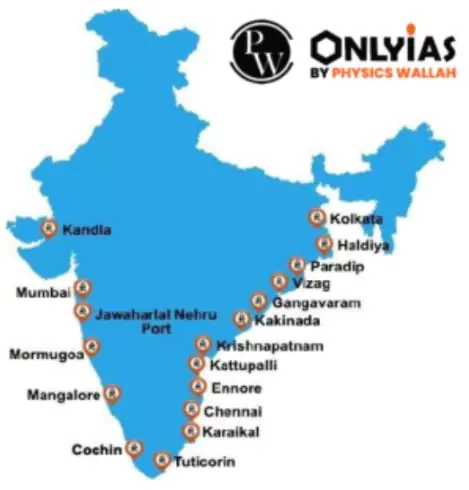Recently, Lok Sabha passed the Indian Ports Bill, 2025. It replaced the Indian Ports Act, 1908.
Objectives of the Bill

- Uniform legal framework for major and non-major ports.
- Enhance port competitiveness through transparent tariff policies.
- Integrate environmental safeguards into port operations.
- Encourage Public-Private Partnerships (PPP) and foreign investment.
- Facilitate cooperative federalism between Centre and States.
Key Features of the Bill
- State Maritime Boards:
- Statutory recognition for administration and regulation of non-major ports.
- Functions:
- Plan and develop port infrastructure.
- Grant licenses.
- Fix tariffs within a transparent framework.
- Ensure compliance with safety, security, and environmental norms.
- Strengthened authority to manage non-major ports effectively.
- Maritime State Development Council (MSDC):
- Provides statutory recognition to MSDC
- Chairperson: Union Minister for Ports, Shipping and Waterways.
- Members: State Ministers, Indian Navy/Coast Guard secretaries, Union Ministry Secretary.
- Functions:
- Coordinate national port development strategies.
- Issue guidelines on tariff transparency, data collection, storage, and dissemination.
- Advise on national perspective plan, legislative adequacy, port efficiency, and connectivity.
- Promotes cooperative federalism for holistic port development.
- Dispute Resolution Committee (DRC):
- Set up by state governments to resolve disputes between non-major ports, concessionaires, users, and service providers.
- Appeals lie with the High Court; civil courts barred from DRC matters.
- Allows arbitration or alternative dispute resolution mechanisms.
- Tariffs:
- Major Ports: Fixed by Board of Major Port Authority or Board of Directors (if registered as a company).
- Non-Major Ports: Fixed by State Maritime Board or authorized concessionaire.
- Emphasizes transparent tariff policies to enhance port competitiveness.
- Safety and Conservation:
- Retains 1908 Act provisions penalizing unsafe actions (e.g., injuring buoys, discharging firearms).
- Environmental Measures: Mandates compliance with MARPOL and Ballast Water Management Convention.
- Ports to prepare:
- Waste reception and handling plans.
- Pollution control and emergency preparedness plans.
- Disaster management plans.
- Central government to conduct periodic audits.
- Promotes renewable energy and shore power systems to reduce emissions.
- Safety Standards: Uniform safety protocols across all ports.
- Offences and Penalties:
- Decriminalization: Some offences now punishable by monetary penalties instead of imprisonment.
- New Offences:
- Starting port operations without notification.
- Failure to report pollution or provide pollution-related facilities.
- Non-compliance with DRC orders.
- Penalties:
- Imprisonment (up to 6 months), fine (up to ₹1 lakh), or both for endangering vessel safety or disturbing waterbed/geophysical structures.
- Compounding allowed for first-time contraventions.
- Economic and Operational Enhancements:
- Digitalization: Simplifies procedures and enhances Ease of Doing Business (EODB).
- Logistics Cost Reduction: Speeds up cargo movement and improves hinterland connectivity.
- Employment Generation: Opportunities in port operations, logistics, warehousing, and allied industries.
- Support for Exporters and MSMEs: Streamlined procedures and improved infrastructure.
- Funding Flexibility: Clear provisions for Public-Private Partnerships (PPPs) and foreign investment.
- Coastal Shipping Boost: Integration with inland waterways and multimodal transport systems.
Key Concerns & Criticisms of the Indian Ports Bill, 2025
- Lack of Appeal Mechanism Against Penalties: The Bill does not provide a mechanism to appeal penalties imposed by the conservator for offences listed in the second schedule.
- This contrasts with other laws like the Jan Vishwas (Amendment of Provisions) Act, 2023, and Bharatiya Vayuyan Adhiniyam, 2024, which allow appeals to higher-ranking officials, ensuring checks and balances.
- Lack of Safeguards for Entry and Inspection Powers: The Bill grants the conservator and health officer powers to enter and inspect vessels within port limits without specifying safeguards.
- Other laws, such as the Occupational Safety, Health, and Working Conditions Code, 2020, and Food Safety and Standards Act, 2006, include safeguards under the Bharatiya Nagarik Suraksha Sanhita (BNSS), 2023, like recording reasons, electronic documentation, and ensuring witnesses.
- Ambiguity on ‘Mega Ports’ Classification: The Bill allows the central government to notify ports as ‘mega ports’ but does not clarify their purpose or provide specific provisions for their governance.
- Mega ports retain their existing classification as major or non-major ports, creating confusion about the need for this additional designation.
Achievements
- Port capacity increased by 87% in the last decade to 2,500 MMTPA (target: 3,300+ MMTPA by 2030).
- Cargo handling: 819.22 million tonnes in FY24, up 4.45% year-on-year.
- Coastal shipping grew by 118%, inland waterways by 700% over a decade.
- Turnaround time reduced from 93 hours to 48 hours (global average: ~23 hours).
- 9 Indian ports in the top 100 of Container Port Performance Index (CPPI) 2023, with Visakhapatnam at 19th rank.
|
Coastal Economy of India
- The coastal economy, a key component of India’s Blue Economy, includes economic activities in marine, maritime, and onshore coastal zones, such as ports, shipping, fisheries, aquaculture, tourism, renewable energy, and marine biotechnology.
- Geographical Scope: India’s coastline spans 11,099 km (revised in 2024 via geospatial mapping) covering,
- Nine coastal states (Gujarat, Maharashtra, Goa, Karnataka, Kerala, Tamil Nadu, Andhra Pradesh, Odisha, West Bengal) and
- Four Union Territories (Daman & Diu, Dadra & Nagar Haveli, Lakshadweep, Andaman & Nicobar Islands).
- Significance:
- Handles 95% of India’s trade by volume and 70% by value.
- Sustains over 4 million fisherfolk and coastal communities.
- Contributes significantly to GDP through trade, logistics, and allied industries.
- Policy Framework:
- Sagarmala Programme (2015): Focuses on port-led development, connectivity, and coastal community upliftment.
- Maritime India Vision 2030: Aims to position India as a global maritime hub by 2030.
- Maritime Amrit Kaal Vision (MAKV) 2047: Targets India among the world’s leading maritime powers through shipbuilding, port infrastructure, and financial resilience.
- National Policy for India’s Blue Economy (2021): Promotes sustainable marine-based economic growth.
Key Features of India’s Coastal Economy
- Maritime Trade and Ports:
- Ports: India operates 12 major ports (e.g., JNPT, Paradip, Deendayal) and 217 non-major ports (66 cargo-handling, 151 for fishing). In 2023-24:
- Major ports: 819 million tonnes (53% of total cargo).
- Non-major ports: 724 million tonnes (47%), with Mundra (173 MT, 11%) and Sikka (128 MT, 8%) leading.
- Fisheries and Aquaculture:
- India is the second-largest fish-producing country globally, with aquaculture contributing 96.5% of aquatic plant output.
- Initiatives:
- Modernizing fishing harbors (e.g., Chennai, Kochi) under Sagarmala.
- Promoting seaweed cultivation for sustainable livelihoods.
- Pradhan Mantri Matsya Sampada Yojana (PMMSY): Targets 22 million tonnes of fish production by 2025, boosting coastal economies.
- Impact: Supports 4 million fisherfolk, enhances export potential, and reduces environmental impact through sustainable practices.
- Coastal Tourism:
- Development of cruise terminals (e.g., Kochi International Cruise Terminal, Mumbai International Cruise Terminal targeting 1 million passengers annually).
- Promotes high-value tourism, creating jobs and diversifying coastal economies.
- Renewable Energy and Sustainability:
- Focus on wind power, wave energy, and shore power systems to reduce emissions.
- Green Energy Corridor in Andhra Pradesh (₹28,436 crore) to connect 11,000 MW renewable energy by 2029.
- Compliance with MARPOL and Ballast Water Management Convention for pollution control.
- Green Ports Initiative: Promotes renewable energy and waste management at ports like Vizhinjam and Tuticorin.
- Marine Biotechnology:
- Exploration of marine organisms for pharmaceuticals, biofuels, and agricultural applications.
- Emerging sector for innovation and economic diversification.
- Maritime Development Fund (MDF):
- Objective: Fund ship acquisition and expand the Indian-flagged fleet.
- Corpus: ₹25,000 crore (49% government, 51% from port authorities, PSUs, private players).
- Goal: Increase India’s share in global cargo movement to 20% by 2047, reducing reliance on foreign vessels.
- Impact: Promotes self-reliance, improves balance of payments, and supports Aatmanirbhar Bharat.
Government Initiatives
- Recent Legislative Reforms:
- Coastal Shipping Bill, 2025 (Passed in August 2025):
- Replaces Part XIV of Merchant Shipping Act, 1958.
- Targets 230 million metric tonnes of coastal cargo by 2030.
- Simplifies licensing, regulates foreign vessels, and promotes Indian-flagged ships to reduce foreign exchange outflow.
- Mandates National Coastal and Inland Shipping Strategic Plan and National Database for Coastal Shipping for transparency and investment.
- Merchant Shipping Bill, 2025 and Carriage of Goods by Sea Bill, 2025: Part of a legislative trilogy to modernize maritime laws, aligning with global cabotage standards.
- Revised Coastline Length: Updated to 11,099 km in 2024, impacting maritime security and Blue Economy strategies.
- Sagarmala Programme (2015):
- Objective: Promote port-led development through:
- Port Modernization: Upgrading existing ports (e.g., Tuticorin, Chennai) and developing new ports (e.g., Vadhavan, Vizhinjam).
- Port Connectivity: Enhancing road, rail, and inland waterway networks (e.g., Western DFC spur lines, Bharatmala highways).
- Coastal Economic Zones (CEZs): Developing 14 CEZs for port-proximate industrialization (e.g., Dholera Smart City, Gujarat).
- Coastal Community Development: Modernizing fishing harbors, skill development, and tourism promotion.
- Impact:
- Over 800 projects worth ₹5.79 lakh crore identified.
- Expected to create ~10 million jobs by 2025.
- Reduces logistics costs by ₹35,000–40,000 crore annually.
- Vizhinjam International Seaport (Commissioned May 2025):
- India’s first deep-water transshipment port (18–20 m draft).
- Developed by Adani Ports & SEZ Ltd via PPP (Kerala: 61.5%, Centre: 9.6%).
- Saves $200–220 million/year previously lost to foreign ports (Colombo, Singapore, Dubai).
- Employs 750+ workers (67% from Kerala, 57% from Thiruvananthapuram), including women crane operators.
- Reduces logistics costs by $80–100 per container and voyage time by 1–2 days.
- Vadhavan Port (Maharashtra): Planned mega port with ₹76,000 crore investment to ease pressure on JNPT.
- Tuticorin International Container Terminal: Handles 6 lakh TEUs annually, boosting capacity by 4 million TEUs.
- Maritime Financing Summit 2025:
- Launched Financial Digital Maturity Matrix (FDMM) for investor-ready port infrastructure.
- 100% FDI allowed in shipping via automatic route.
- GIFT City IFSC enabled for ship leasing and financing.
- Maritime India Vision 2030: Aims to position India as a global maritime hub by 2030.
- Maritime Amrit Kaal Vision (MAKV) 2047: Targets India among the world’s leading maritime powers through shipbuilding, port infrastructure, and financial resilience.
- National Policy for India’s Blue Economy (2021): Promotes sustainable marine-based economic growth.
Key Issues and Challenges
- Environmental Degradation: Port expansion and dredging risk coastal erosion, wetland destruction, and marine biodiversity loss (e.g., Vizhinjam protests in 2022–23 over erosion fears).
- Oil spills (e.g., MSC ELSA 3) underscore pollution threats.
- Displacement of Communities: Infrastructure projects may displace fisherfolk and indigenous communities without adequate rehabilitation.
- High Logistics Costs: India’s logistics costs (13–14% of GDP) are higher than the global average (8–9%).
- Regional Imbalances: Gujarat and Maharashtra dominate port investments, potentially neglecting eastern states like Odisha and West Bengal.
- Climate Change Vulnerability: Sea-level rise, cyclones, and flooding threaten coastal infrastructure.
- Regulatory Gaps: Indian Ports Bill, 2025 lacks appeal mechanisms for conservator penalties and safeguards for inspection powers, risking misuse.
- Ambiguity in ‘mega ports’ classification may create regulatory confusion.
- Infrastructure Constraints: Shallow drafts, outdated equipment, and congestion at major ports (turnaround time: 50.7 hours vs. global 12 hours).
- Financing Challenges: High investment needs (₹5.79 lakh crore under Sagarmala) require sustained PPPs.
- Only 31 of 45 PPP projects have attracted ₹45,973 crore so far.
Way Forward
- Enhance Multimodal Connectivity: Strengthen rail, road, inland waterways, and pipeline linkages (e.g., Jal Marg Vikas, Western DFC, Bharatmala highways).
- Divert 10% of cargo from road/rail to waterways by 2030.
- Promote Green Ports: Adopt renewable energy, shore power, and green dredging to reduce emissions.
- Develop zero-emission ports as per Maritime India Vision 2030.
- Strengthen Port-Based Industrialization: Accelerate 14 Coastal Economic Zones (CEZs) for sectors like steel, cement, electronics, and food processing.
- Link industrial clusters to ports (e.g., Dholera Smart City to Pipavav/Kandla).
- Increase Private and FDI Participation: Simplify land acquisition and environmental clearances.
- Leverage 100% FDI in shipping and GIFT City IFSC for financing.
- Digitalization and Automation: Deploy Port Community System (PCS1x), Enterprise Business System (EBS), and AI-driven systems like Vizhinjam’s VTMS to reduce dwell time to global standards (~12 hours).
- Expand Transshipment Capacity: Develop hubs like Vizhinjam, Vadhavan, and Enayam to capture 45% of India’s transshipment currently handled by foreign ports (e.g., Colombo).
- Empower Coastal Communities: Invest in skill development, fishermen welfare, and Blue Economy initiatives (e.g., 30,000+ beneficiaries under Sagarmala).
- Promote gender inclusion (e.g., women crane operators at Vizhinjam).
- Policy Implementation: Execute National Coastal and Inland Shipping Strategic Plan and National Policy for India’s Blue Economy-2021.
- Use PM Gati Shakti for real-time project monitoring and upskill 5 lakh workers via Sagarmala Skill Centers by 2030.
Conclusion
The Indian Ports Bill, 2025, and allied reforms like the Coastal Shipping Bill represent a pivotal shift towards a modern, sustainable maritime ecosystem, fostering integrated port development and reducing logistics costs. By leveraging initiatives such as Sagarmala and the Maritime Development Fund, India aims to harness its vast coastline for economic growth, job creation, and global competitiveness.
![]() 16 Aug 2025
16 Aug 2025


